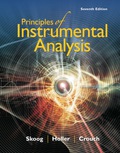
Interpretation:
The absorption frequency for
Concept introduction:
An absorption band consists of a range of the energy and the wavelength in the
Answer to Problem 16.3QAP
The absorption frequency corresponding to the
The calculated value lies near to the range found in the correlation charts.
The absorption frequency for
Explanation of Solution
The expression for the wave number is:
Here, the velocity of light is
The expression for the reduced mass is:
Here, mass of the carbon atom is
Substitute
Substitute
Thus, the absorption frequency corresponding to the
The absorption frequency of
The expression for the wave number is:
The expression for the reduced mass is:
Here, mass the mass of the hydrogen atom is
Substitute
Substitute
Thus, the absorption frequency for
The absorption frequency corresponding to the
The calculated value lies near to the range found in the correlation charts.
The absorption frequency for
Want to see more full solutions like this?
Chapter 16 Solutions
Principles of Instrumental Analysis
- Calculate the frequency in Hertz, the energy in Joules, and the energy in electron volts of an X-ray photon with a wavelength of 6.24 Å. Calculate the frequency in Hertz, the wavenumber (in cm-1), the energy in Joules, and the energy in KJ/mol associated with the 3.517-um vibrational absorption band of an aliphatic ketone. • The scale of a spectrophotometer extends from 1 to 100% T, what are the values of these two extremes in absorbance? a. 0, 2.0 b. 2.0, 0 c. 0, 1.99 d. 1.99, 0 Convert the 98% T to absorbance: c. 0.021 a. 0.008 d. 0.21 b. 0.08arrow_forwardIn a hydrogen-oxygen flame, the atomic absorption signal for iron was found to decrease in the presence of high concentrations of sulfate. Suggest an explanation for this observation and propose one possible method for overcoming the potential interference of sulfate in the quantitative determination of iron.arrow_forwardWhat factors influence the wavelength of maximum emission and maximum excitation in fluorescence spectroscopy?arrow_forward
- Explain the difference of an operational principle between flame atomic absorption spectroscopy (FAAS) and flame atomic emission spectroscopy (AES). Predict the type of interference caused by the formation of metal ion-anion compounds which are difficult to be dissociated in flame.arrow_forwardAbsorbance has no units. Please derive the units of the molar extinction coefficient ε.arrow_forwardA solution shows a transmittance of 20%, when taken in a cell of 2.5 cm thickness. Calculate concentration of this solution of its molar absorption coefficient is 12000 dm³ mol·1 cm!.arrow_forward
- Adenine has a molar extinction coefficient of 7020 mol dm–3 cm–1 at a wavelength of 265 nm and a characteristic NH2 bending vibration at 1650 cm–1. Show your working for each stage of this question. a) Calculate the transmission of 265 nm light through a 2.0×10–4 molar solution of adenine in a 0.5 cm wide cuvette. b) Calculate, ω, the fundamental frequency of the NH2 bend (in s–1).arrow_forwardDescribe the basic differences between fundamental vibrations and overtones in IR spectroscopy.arrow_forwardShow COMPLETE solutions. Round-off FINAL answer to the 4th decimal The absorption coefficient of Sample Z at 340 nm is 600 Mol-1cm-1. What absorbance will be observed when light at 340 nm passes through a 1 cm cuvette containing 0.001M Sample zk A solution put in a 1.5 cm container transmits 55% incident light. Calculate the concentration of the solution, given that ɛ = 6x10-3 Mol-1cm-1. A solution shows a transmittance of 39.72%, when taken in a container measuring 3.5 cm thickness. Calculate its concentration, if the molar absorption coefficient is 3x10-2 Mol-1cm- 1.arrow_forward
- When pyridine is added to a solution of iodine in carbon tetrachloride the 520 nm band of absorption shifts toward 450 nm. However, the absorbance of the solution at 490 nm remains constant: this feature is called an isosbestic point. Show that an isosbestic point should occur when two absorbing species are in equilibrium.arrow_forward4. Given that the concentration of the compound giving rise to the absorption (A=0.4520) is 8.62 mmol L-¹, what is the molar absorption coefficient when measured through a cell of length 0.20 cm?arrow_forwardThe molar absorption coefficient of a substance dissolved in hexane is known to be 227 dm3mol-1cm-1 at 290 nm. Calculate the percentage reduction in intensity when UV radiation of that wavelength passes through 2.00 mm of a solution of concentration 2.52 mmol dm-3.arrow_forward
 Principles of Instrumental AnalysisChemistryISBN:9781305577213Author:Douglas A. Skoog, F. James Holler, Stanley R. CrouchPublisher:Cengage Learning
Principles of Instrumental AnalysisChemistryISBN:9781305577213Author:Douglas A. Skoog, F. James Holler, Stanley R. CrouchPublisher:Cengage Learning
